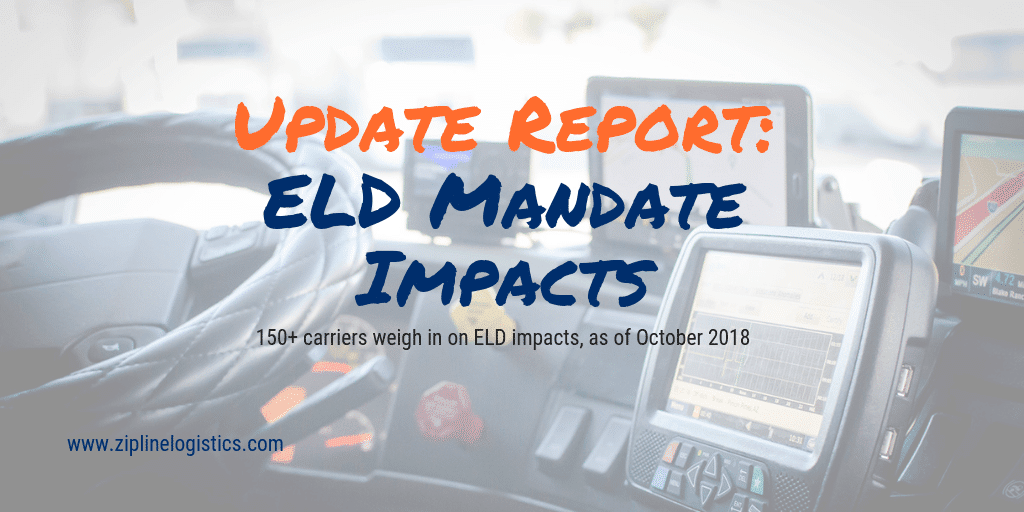Zipline Logistics’ carrier team surveyed more than 150 trucking companies in our network about the Electronic Logging Device (ELD) Mandate and its impacts.
Goals of the survey included seeing how the market has adjusted since the December 2017 rollout of the Mandate, what preferences and procedures have changed with fleets, and how drivers and dispatchers feel since its introduction.
This survey builds on Zipline’s initial ELD survey report that was released in March 2018.
Summary of Major ELD Survey Findings
- The ELD Mandate has required fleets to expand to handle the same level of orders, but they are being held back by the increasing driver shortage.
- Driver shortage was listed as the biggest factor affecting the market and rates currently, not ELDs.
- Under the Mandate, 77% of carriers reported being more selective in the shippers/receivers that they are willing to go to.
- 54% of carriers have changed how long they will wait at a shipper/receiver since the ELD Mandate.
- 60% of fleets surveyed felt that safety is improving among their drivers. This mirrors survey results from March 2018.
- When it comes to rates, 48% of carriers felt that linehaul rates have increased due to ELDs. This is different than survey results from March 2018 where 71% of respondents said per mile rates increased due to ELDs.
ELDs and Fleet Size
The majority of fleets surveyed were moderately sized between 6-100 trucks and the majority of fleets employed company drivers.
67.55% of the fleets surveyed were compliant prior to the ELD mandate while another 21.85% of fleets were compliant by the ELD enforcement date in April 2018.
Responses show that the ELD Mandate has required fleets to expand to handle the same level of orders, but they are being held back by the increasing driver shortage.
ELDs and Length of Haul Preferences
Since our first survey, the majority of carriers have not changed their length of haul preferences. However, smaller carriers with 30 or fewer trucks were the most polarized, with 37% reporting they prefer haul lengths that are shorter than 500 miles and only 15% preferring 500+ miles.
ELD Safety Impacts
The survey asked drivers and dispatchers if they felt ELDs were doing what they were intended to do; increase safety on the road.
60% of fleets surveyed felt that safety was improving among their drivers. They shared that ELDs were forcing drivers to stop, rest, and run legally.
The other 40% of respondents felt that ELDs were decreasing the safety of drivers and others on the road. They responded that drivers are speeding more and driving recklessly to cover more ground in the time allotted by ELDs and meet strict deadlines. Drivers also mentioned that they are now forced to drive in hazardous weather and when tired so they do not burn their ELD hours after they are already running.
These findings leave a large gap in determining whether ELDs are doing what they were intended to do and what the actual consequences are of the regulation. It is important to note that these findings on safety are the same as our survey conducted in March 2018.
Detention and Carrier Preferences
Our survey showed that 77% carriers are much more selective in the shippers and receivers that they are willing to load in/out of since the Mandate and that 80% of carriers state that there are now facilities they will absolutely not load out of.
43% of carriers state that the amount of shipper/receivers they refuse to go to has increased since the ELD mandate. These warehouses all have a reputation of long load and unload times.
Only 17% of carriers will wait as long as it takes to be loaded while the majority will wait only up to 4 hours before pulling their drivers.
54% of carriers have changed how long they will wait since the ELD Mandate. Carriers stated they also tend to avoid any shipper or receiver that has strict appointment times and does not offer delivery windows.
Drivers shared that they feel there is a major disconnect between shippers/receivers and the ELD mandate. Carriers feel that some places do not care or do not understand the effect of the ELD regulation. The more a shipper or receiver can accommodate a driver, the easier it will be to get a truck into that facility at a better rate.
ELDs and Freight Rates
When it comes to rates, 48% of carriers felt that linehaul rates have increased due to ELDs while 33% felt that ELDs weren’t the reason for the rate increase.
This is different than survey results from March 2018 where 71% of respondents said per mile rates increased due to ELDs. This difference suggests that carriers have uncovered new efficiencies in the last 6 months.
In our survey results, driver shortage was listed as the biggest factor that affects the market and rates currently, not ELDs on their own.
Some comments suggested that there needs to be an industry-wide review of HOS regulations to include the 14-hour rule as well as some drivers feel that lawmakers are out of touch with the regulations they are enacted and not seeing the unintended consequences.
—
Access the full report here for more commentary and driver insights:

